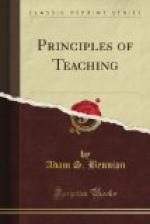And, finally, as a key to interest, a teacher needs to know what the “factors of interestingness” are. According to the findings of the Public Speaking Department of the University of Chicago, they are summed up in these seven terms:
The Vital
The Unusual
The Uncertain
The Concrete
The Similar
The Antagonistic
The Animate
This list becomes more and more helpful as it is pondered. It is surprising to find how experience can be explained on the score of interest by reference to these terms. Those things are vital which pertain to life—which affect existence. Dangers are always interesting. Catastrophies are fascinating. Just today all America is scanning the newspapers throughout the country to find an explanation of the Wall Street explosion. We shall not soon forget the feverish interest that gripped the people of the world during our recent world wars.
When life is at stake, interest runs high. So it does when property, liberty, and other sacred rights, so vital to life, are affected. Anything vital enough to justify the publication of an “extra” may be depended upon to grip the interest of men and women.
It is equally clear that a fascination attaches to things that are unusual. New styles attract because of this fact. Let a man oddly dressed walk along a thoroughfare—the passersby are interested immediately. A “loud” hat or necktie, or other item of apparel, attracts attention because it is out of the ordinary. Much of the interest and delight in traveling lies in this element of the new and unusual which the traveler encounters. The experiences of childhood which stand out most prominently are usually those which at the time riveted themselves to the mind through the interest of their extraordinariness.
Every reader knows the fascination of uncertainty. “How will the book turn out?” prompts many a person to turn through hundreds of pages of a novel. An accident is interesting not only because of its vital significance, but because there is always a question as to how seriously those involved may be hurt. One of the clearest illustrations of the force of the uncertain is found attending baseball games. Let the score stand at 10 to 2 in the eighth inning and the grandstands and bleachers begin to empty. Few spectators care to remain. The game is too clearly settled. As the boys say, it is “sewed up” and there is nothing uncertain to grip interest. But let the score stand 3 to 2 or 2 to 2 in the eighth and even the man scheduled home for dinner stays to the end. He wants to know how the game is “coming out.”
It is easier also to be interested in concrete than in abstract things. General truths are not gripping—concrete illustrations of those truths are. If I declare that it is important to have faith, I create but little interest in an audience. But if I tell that same audience how some individual has been miraculously healed through faith, I have their interest completely. Concrete illustrations fit into and link up with our own experiences so easily and forcefully that they are particularly interesting.




